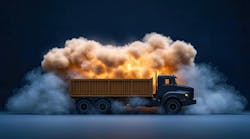Market Pulse: Navigating 2025’s early used truck market amid tariffs and uncertainty
The used truck market has been on a rollercoaster ride this decade. From pandemic-fueled price surges to freight recession regressions, the landscape is shifting again in 2025, which could create opportunities for fleets.
After months of continued price declines, used commercial truck sales rebounded as 2024 ended, showing year-over-year improvements compared to 2023.
“We had clearly found the bottom in the used truck market price arena, and we're starting to lift ourselves off that bottom,” Steve Tam, a VP and analyst with ACT Research, said on Market Pulse on FleetOwner.com. “That's a very encouraging sign, actually, not only for dealers, but I think buyers are relieved because ultimately, if they're buying, they're probably also selling as they're trading.”
Tam noted that the recovery isn't uniform across all Class 8 segments. Sleeper tractors, often considered more of a commodity, initially saw the most rapid price increases but experienced steeper declines.
Daycabs, which lagged behind sleepers in both the initial surge and subsequent fall, are still seeing a slightly faster rate of price decrease. Interestingly, vocational equipment has proven to be the most stable, experiencing a more moderate price run-up and a less significant decline, indicating consistent demand.
Adding a layer of complexity are potential Trump tariffs on Mexico and Canada, which the White House has toggled between implementing and delaying. The latest tariff deadline for North American trading partners is in the first week of April.
While domestic used trucks wouldn't be directly subject to these tariffs, Tam outlined a potential indirect impact. If tariffs are imposed on new vehicles, used trucks could become a more attractive alternative, potentially increasing demand in a relatively stable supply environment and prices.
In the video at the top of the page, Tam also discusses how regulations impact used trucks, what rising new Class 8 prices mean for used equipment, and what the low production output in 2020 and 2021 means for 2025 and 2026.
For a deeper dive into the nuances of the early 2025 used truck market, including concrete data points and further analysis, subscribe to the FleetOwner YouTube channel.
About the Author
Josh Fisher
Editor-in-Chief
Editor-in-Chief Josh Fisher has been with FleetOwner since 2017. He covers everything from modern fleet management to operational efficiency, artificial intelligence, autonomous trucking, alternative fuels and powertrains, regulations, and emerging transportation technology. Based in Maryland, he writes the Lane Shift Ahead column about the changing North American transportation landscape.


